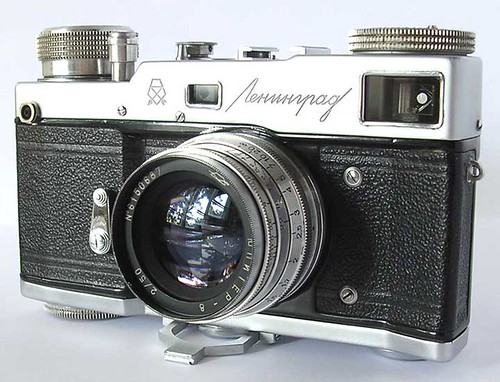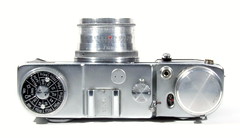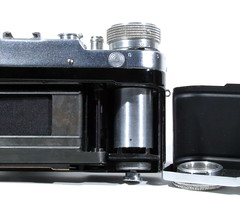Difference between revisions of "Leningrad"
(→Bibliography: + template) |
m (Updated LPA link) |
||
| (16 intermediate revisions by 2 users not shown) | |||
| Line 1: | Line 1: | ||
| + | __NOTOC__ | ||
{{Flickr_image | {{Flickr_image | ||
|image_source= http://www.flickr.com/photos/markwaldron/363060995/in/pool-camerawiki/ | |image_source= http://www.flickr.com/photos/markwaldron/363060995/in/pool-camerawiki/ | ||
| Line 7: | Line 8: | ||
|image_rights= with permission | |image_rights= with permission | ||
}} | }} | ||
| − | The '''Leningrad''' (Ленинград) is a [[35mm]] [[rangefinder camera]] manufactured by [[GOMZ]], (ГОМЗ, Государственный оптико-механический завод, Ленинград = Gosularstvennyi Optiko-Mekhanicheskii Zavod =State Optical-Mechanical Factory), Leningrad, USSR. It conceived by I. Shapiro and produced between 1956-68. | + | The '''Leningrad''' (Ленинград) is a [[35mm]] [[rangefinder camera]] manufactured by [[GOMZ]], (ГОМЗ, Государственный оптико-механический завод, Ленинград = Gosularstvennyi Optiko-Mekhanicheskii Zavod =State Optical-Mechanical Factory), Leningrad, USSR. It was conceived by I. Shapiro and developed at [[GOI]],<ref>A [https://www.leitz-auction.com/en/GOI-Leningrad-prototype-outfit/AI-37-38571 prototype Leningrad] outfit made at GOI, comprising the camera body, serial no. 2092, ''without spring motor'', plus three lenses, case and wooden box for the lenses, was sold at the [https://www.leitz-auction.com/en/Cameras/Past-Auctions/Auction-37/ 37th Leitz Photographica Auction], in November 2020. In addition to manual film advance, the prototype has its own ''bayonet'' lens-mount, and rather different controls to the production camera. The auctioneer dates it to about 1948.</ref> and produced industrially by GOMZ between 1956-68. It has a spring motor advance, and takes [[39mm screw lenses]]. |
The clockwork winding mechanism, a spring-powered mechanical motor, does not allow continuous shooting; for every frame you must release the shutter. It takes about 20 pictures after one full actuation of the spring, it is possible 3 frames per second (if you can do it). There is absolutely no way to advance film and to cock the shutter other than via the spring motor. There are engravings on the right side of the top plate as 0-5-10-15-20, with a pointer beneath the motor drive knob shows the count of frames that will be taken when the spring drive is cocking.<ref>If Leningrad suddenly decides not to advance the film after you've taken try turning the shutter speed dial slightly counterclockwise against spring tension, then letting it snap back. Often this will release the mechanism and let the film advance to the next frame. And since (as noted above) there's no alternate manual way to advance the film, you'd better hope this trick works!</ref> | The clockwork winding mechanism, a spring-powered mechanical motor, does not allow continuous shooting; for every frame you must release the shutter. It takes about 20 pictures after one full actuation of the spring, it is possible 3 frames per second (if you can do it). There is absolutely no way to advance film and to cock the shutter other than via the spring motor. There are engravings on the right side of the top plate as 0-5-10-15-20, with a pointer beneath the motor drive knob shows the count of frames that will be taken when the spring drive is cocking.<ref>If Leningrad suddenly decides not to advance the film after you've taken try turning the shutter speed dial slightly counterclockwise against spring tension, then letting it snap back. Often this will release the mechanism and let the film advance to the next frame. And since (as noted above) there's no alternate manual way to advance the film, you'd better hope this trick works!</ref> | ||
| − | The film take-up system is unique as it ignores sprocket holes on 35mm film. Instead it winds the film onto a fat take-up spool (drum). No account is taken of the increasing diameter of this spool as film is wound onto it, resulting in increasingly wide gaps between the frames on a roll. Modern automated negative cutting will not adjust for the unique frame layout, and negatives and slides must be ordered from labs uncut | + | The film take-up system is unique as it ignores the sprocket holes on 35mm film. Instead it winds the film onto a fat take-up spool (drum). No account is taken of the increasing diameter of this spool as film is wound onto it, resulting in increasingly wide gaps between the frames on a roll. Modern automated negative cutting will not adjust for the unique frame layout, and negatives and slides must be ordered from labs uncut (individual mounting of the slides must therefore be done by the user). Users of the Leningrad consider this not a bug but a feature. |
Leningrads were supplied with a standard Jupiter-8 lens and will accept most [[39mm screw lenses]]. An over-hanging lip just above the lens mount makes it impossible to mount certain lenses. | Leningrads were supplied with a standard Jupiter-8 lens and will accept most [[39mm screw lenses]]. An over-hanging lip just above the lens mount makes it impossible to mount certain lenses. | ||
| − | Built very sturdily, and to a very high degree of precision | + | Built very sturdily, and to a very high degree of precision, the Leningrad is said to be the most advanced (and expensive) Soviet rangefinder ever made. Many were given as presents to party members and visiting dignitaries. At the 1958 World Exposition in Brussels, the Leningrad was awarded the "Grand Prix de Bruxelles”. Modified Leningrads were used in the Soviet space program. |
Just 76,000 units were made, a small number by Soviet standards. It is not known how many survive. | Just 76,000 units were made, a small number by Soviet standards. It is not known how many survive. | ||
| − | There are 7 types and 4 sub-types of the | + | There are 7 types and 4 sub-types of the camera.<ref>Types are according to Alaxander Komarov in [https://web.archive.org/web/20130414034952/http://www.fotoua.com/2.php?seek1=588&usl=&usl1=&rd=&st= Fotoua] (archived). You can also find serial numbers for dating of the cameras in this site. There is another classification of former-USSR cameras by Aidas Pikiotas at [http://www.sovietcams.com/indexd8e4.html?tmpl_into=middle&tmpl_id=204&_m_e_id=20&_menu_i_id=160 SovietCams]</ref><ref> Pages from the the book of former USSR cameras by [http://img.inkfrog.com/click_enlarge1.php?image=IMG_3609.JPG&username=calicurg&aid=972050785 Suglob, Shaternik, Kochergin]</ref> <ref>Discussion of camera classifications in the books of Princelle and Suglob, Shaternik, Kochergin in [http://www.ussrphoto.com/Forum/topic.asp?TOPIC_ID=1500 USSR Photo Forum]</ref> |
==Some features== | ==Some features== | ||
| Line 24: | Line 25: | ||
* Lens: [[Jupiter]]-8 (ИНДУСТАР), 50mm f/2, coated, Mount: M39 screw, filter thread 35mm, made by [[KMZ]] | * Lens: [[Jupiter]]-8 (ИНДУСТАР), 50mm f/2, coated, Mount: M39 screw, filter thread 35mm, made by [[KMZ]] | ||
* Focusing: matching rangefinder split images in the viewfinder | * Focusing: matching rangefinder split images in the viewfinder | ||
| − | * Shutter: [[Focal plane shutter]], rubberized silk double cloth curtain, | + | * Shutter: [[Focal plane shutter]], rubberized silk double cloth curtain, travelling horizontally, speeds 1- 1/1000 +B, plus [[flash sync|bulb sync]]. 1/25s |
| − | * Viewfinder: coupled Galilean viewfinder/rangefinder, (.68x), bright frame lines for 50, 85 and 135mm lenses, w/ a split image rangefinder with 57mm base. The whole finder covering the 35mm focal length. There is a diopter adjustment ring on the | + | * Viewfinder: coupled Galilean viewfinder/rangefinder, (.68x), bright frame lines for 50, 85 and 135mm lenses, w/ a split image rangefinder with 57mm base. The whole finder covering the 35mm focal length. There is a diopter adjustment ring on the eyepiece. |
| − | * [[Self-timer]] <ref>An inoperable self-timer is a common problem on the Leningrad because if the timer is set without the camera being wound, it breaks </ref> | + | * [[Self-timer]] <ref>An inoperable self-timer is a common problem on the Leningrad because if the timer is set without the camera being wound, it breaks. </ref> |
* Adjustable flash synch delay 5 - 20 milliseconds | * Adjustable flash synch delay 5 - 20 milliseconds | ||
* Back cover: removable with the bottom plate | * Back cover: removable with the bottom plate | ||
| Line 36: | Line 37: | ||
|image= http://farm3.static.flickr.com/2018/5820085749_9975661931.jpg | |image= http://farm3.static.flickr.com/2018/5820085749_9975661931.jpg | ||
|image_align= center | |image_align= center | ||
| − | |image_text= Leningrad type 1b (1957), <ref>This type 1b is a rare one. With type 1a this camera is earliest so far known | + | |image_text= Leningrad type 1b (1957), <ref>This type 1b is a rare one. With type 1a this camera is earliest so far known production version of Leningrad</ref> |
|image_by= Süleyman Demir | |image_by= Süleyman Demir | ||
|image_rights= with permission | |image_rights= with permission | ||
| Line 42: | Line 43: | ||
{|class=plainlinks align="center" | {|class=plainlinks align="center" | ||
| − | + | | | |
{{Flickr_image | {{Flickr_image | ||
|image_source= http://www.flickr.com/photos/s-demir/5820086603/in/pool-camerawiki/ | |image_source= http://www.flickr.com/photos/s-demir/5820086603/in/pool-camerawiki/ | ||
| Line 51: | Line 52: | ||
|image_rights= | |image_rights= | ||
}} | }} | ||
| − | + | | | |
{{Flickr_image | {{Flickr_image | ||
|image_source= http://www.flickr.com/photos/s-demir/5820088021/in/pool-camerawiki/ | |image_source= http://www.flickr.com/photos/s-demir/5820088021/in/pool-camerawiki/ | ||
| Line 60: | Line 61: | ||
|image_rights= | |image_rights= | ||
}} | }} | ||
| − | + | | | |
{{Flickr_image | {{Flickr_image | ||
|image_source= http://www.flickr.com/photos/s-demir/5820087265/in/pool-camerawiki/ | |image_source= http://www.flickr.com/photos/s-demir/5820087265/in/pool-camerawiki/ | ||
| Line 79: | Line 80: | ||
* {{Princelle USSR}} | * {{Princelle USSR}} | ||
In Russian | In Russian | ||
| − | * 1200 Cameras from USSR by Suglob, Shaternik, Kochergin, 2009 , [http://www. | + | * 1200 Cameras from USSR by Suglob, Shaternik, Kochergin, 2009 , [http://www.novacon.com.br/books6.htm more info about book] |
==Links== | ==Links== | ||
| − | * [http://www.sovietcams.com/ | + | *[https://www.butkus.org/chinon/russian/leningrad/leningrad.htm Leningrad user manual] at [https://www.butkus.org/chinon/ Butkus.org] |
| + | * [http://www.sovietcams.com/indexd8e4.html?tmpl_into=middle&tmpl_id=204&_m_e_id=20&_menu_i_id=160 in SovietCams by Aidas Pikiotas] | ||
* [http://www.photoethnography.com/ClassicCameras/Leningrad.html in Photoethnography Karen Nakamura] | * [http://www.photoethnography.com/ClassicCameras/Leningrad.html in Photoethnography Karen Nakamura] | ||
| − | * [http://www.fotoua.com/ | + | * [https://web.archive.org/web/20130414034952/http://www.fotoua.com/2.php?seek1=588&usl=&usl1=&rd=&st= in Fotoua by Alexander Komarov] (archived) |
| − | * [http://www.collection-appareils.fr/x/html/page_standard.php?id_appareil=11017 Leningrad] | + | * [http://www.collection-appareils.fr/x/html/page_standard.php?id_appareil=11017 Leningrad] at [http://www.collection-appareils.fr/carrousel/html/index.php Collection Appareils] by Sylvain Halgand (in French) |
| − | [[Category: 39mm screw mount]] | + | *[https://www.leitz-auction.com/en/Lomo-Underwater-Housing-for-Leningrad/AI-37-39014 Underwater housing for Leningrad], by [[LOMO]], offered for sale at the [https://www.leitz-auction.com/en/Cameras/Past-Auctions/Auction-37/ 37th Leitz Photographica Auction], in November 2020. |
| − | [[Category: Spring motor]] | + | |
| + | [[Category:39mm screw mount]] | ||
| + | [[Category:Spring motor]] | ||
[[Category:Soviet cameras]] | [[Category:Soviet cameras]] | ||
| − | [[Category: GOMZ]] | + | [[Category:GOMZ]] |
| − | [[Category: L]] | + | [[Category:L]] |
| − | [[Category: Topography]] | + | [[Category:Topography]] |
Latest revision as of 18:26, 4 January 2024

|
| Leningrad type 2a (1958) image by Mark Waldron (Image rights) |
The Leningrad (Ленинград) is a 35mm rangefinder camera manufactured by GOMZ, (ГОМЗ, Государственный оптико-механический завод, Ленинград = Gosularstvennyi Optiko-Mekhanicheskii Zavod =State Optical-Mechanical Factory), Leningrad, USSR. It was conceived by I. Shapiro and developed at GOI,[1] and produced industrially by GOMZ between 1956-68. It has a spring motor advance, and takes 39mm screw lenses.
The clockwork winding mechanism, a spring-powered mechanical motor, does not allow continuous shooting; for every frame you must release the shutter. It takes about 20 pictures after one full actuation of the spring, it is possible 3 frames per second (if you can do it). There is absolutely no way to advance film and to cock the shutter other than via the spring motor. There are engravings on the right side of the top plate as 0-5-10-15-20, with a pointer beneath the motor drive knob shows the count of frames that will be taken when the spring drive is cocking.[2]
The film take-up system is unique as it ignores the sprocket holes on 35mm film. Instead it winds the film onto a fat take-up spool (drum). No account is taken of the increasing diameter of this spool as film is wound onto it, resulting in increasingly wide gaps between the frames on a roll. Modern automated negative cutting will not adjust for the unique frame layout, and negatives and slides must be ordered from labs uncut (individual mounting of the slides must therefore be done by the user). Users of the Leningrad consider this not a bug but a feature.
Leningrads were supplied with a standard Jupiter-8 lens and will accept most 39mm screw lenses. An over-hanging lip just above the lens mount makes it impossible to mount certain lenses.
Built very sturdily, and to a very high degree of precision, the Leningrad is said to be the most advanced (and expensive) Soviet rangefinder ever made. Many were given as presents to party members and visiting dignitaries. At the 1958 World Exposition in Brussels, the Leningrad was awarded the "Grand Prix de Bruxelles”. Modified Leningrads were used in the Soviet space program.
Just 76,000 units were made, a small number by Soviet standards. It is not known how many survive. There are 7 types and 4 sub-types of the camera.[3][4] [5]
Some features
- Lens: Jupiter-8 (ИНДУСТАР), 50mm f/2, coated, Mount: M39 screw, filter thread 35mm, made by KMZ
- Focusing: matching rangefinder split images in the viewfinder
- Shutter: Focal plane shutter, rubberized silk double cloth curtain, travelling horizontally, speeds 1- 1/1000 +B, plus bulb sync. 1/25s
- Viewfinder: coupled Galilean viewfinder/rangefinder, (.68x), bright frame lines for 50, 85 and 135mm lenses, w/ a split image rangefinder with 57mm base. The whole finder covering the 35mm focal length. There is a diopter adjustment ring on the eyepiece.
- Self-timer [6]
- Adjustable flash synch delay 5 - 20 milliseconds
- Back cover: removable with the bottom plate
- Body: metal; Weight: 850g
- Serial no.: first two digits show the manufacturing year, in the cold shoe

|
| Leningrad type 1b (1957), [7] image by Süleyman Demir (Image rights) |
|
|
| ||||||
| Leningrad type 1b (1957) images by Süleyman Demir (Image rights) | ||||||||
Notes and references
- ↑ A prototype Leningrad outfit made at GOI, comprising the camera body, serial no. 2092, without spring motor, plus three lenses, case and wooden box for the lenses, was sold at the 37th Leitz Photographica Auction, in November 2020. In addition to manual film advance, the prototype has its own bayonet lens-mount, and rather different controls to the production camera. The auctioneer dates it to about 1948.
- ↑ If Leningrad suddenly decides not to advance the film after you've taken try turning the shutter speed dial slightly counterclockwise against spring tension, then letting it snap back. Often this will release the mechanism and let the film advance to the next frame. And since (as noted above) there's no alternate manual way to advance the film, you'd better hope this trick works!
- ↑ Types are according to Alaxander Komarov in Fotoua (archived). You can also find serial numbers for dating of the cameras in this site. There is another classification of former-USSR cameras by Aidas Pikiotas at SovietCams
- ↑ Pages from the the book of former USSR cameras by Suglob, Shaternik, Kochergin
- ↑ Discussion of camera classifications in the books of Princelle and Suglob, Shaternik, Kochergin in USSR Photo Forum
- ↑ An inoperable self-timer is a common problem on the Leningrad because if the timer is set without the camera being wound, it breaks.
- ↑ This type 1b is a rare one. With type 1a this camera is earliest so far known production version of Leningrad
Bibliography
In English
- Princelle, Jean Loup (2004), The Authentic Guide to Russian and Soviet Cameras ('Made in USSR'), Le Reve Edition. ISBN 2952252106; or the earlier edition: Hove Foto Books, 2nd edition, 1995. 200 pages. ISBN 1874031630. Paperback.
In Russian
- 1200 Cameras from USSR by Suglob, Shaternik, Kochergin, 2009 , more info about book
Links
- Leningrad user manual at Butkus.org
- in SovietCams by Aidas Pikiotas
- in Photoethnography Karen Nakamura
- in Fotoua by Alexander Komarov (archived)
- Leningrad at Collection Appareils by Sylvain Halgand (in French)
- Underwater housing for Leningrad, by LOMO, offered for sale at the 37th Leitz Photographica Auction, in November 2020.


